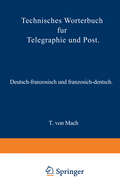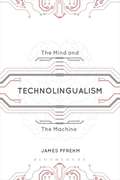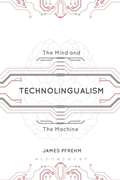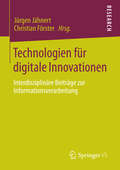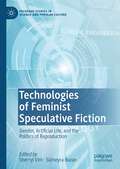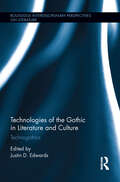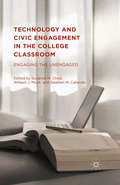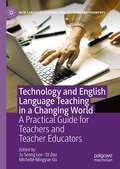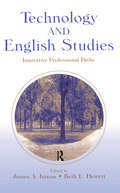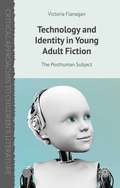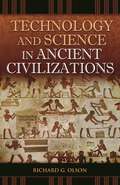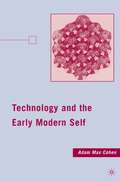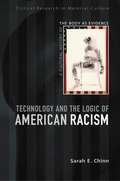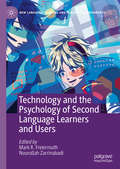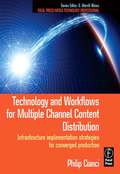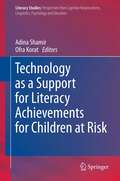- Table View
- List View
Technisches Wörterbuch für Telegraphie und Post: Deutsch-französisch und französisch-deutsch
by T. von MachTechno Politics in Presidential Campaigning: New Voices, New Technologies, and New Voters
by John Allen Hendricks Lynda Lee KaidThe 2008 US presidential campaign saw politicians utilizing all types of new media -- Facebook, MySpace, YouTube, Twitter, e-mail, and cell phone texting – to reach voters of all ages, ethnicities, socio-economic backgrounds, and sexual orientations. This volume examines the use of these media and considers the effectiveness of reaching voters through these channels. It explores not only the use of new media and technologies but also the role these tactics played in attracting new voters and communicating with the electorate during the 2008 presidential debates. Chapters focus on how the technologies were used by candidates, the press, and voters.
Techno Politics in Presidential Campaigning: New Voices, New Technologies, and New Voters
by John Allen Hendricks Lynda Lee KaidThe 2008 US presidential campaign saw politicians utilizing all types of new media -- Facebook, MySpace, YouTube, Twitter, e-mail, and cell phone texting – to reach voters of all ages, ethnicities, socio-economic backgrounds, and sexual orientations. This volume examines the use of these media and considers the effectiveness of reaching voters through these channels. It explores not only the use of new media and technologies but also the role these tactics played in attracting new voters and communicating with the electorate during the 2008 presidential debates. Chapters focus on how the technologies were used by candidates, the press, and voters.
Technocities: The Culture and Political Economy of the Digital Revolution
by John Downey Professor Jim McguiganInformation and communication technologies are said to be transforming urban life dramatically and bringing about rapid economic and cultural globalization. This book explores the many fascinating and urgent issues involved by relating advanced theoretical debates to practical matters of communication with cultural policy. It maps out a range of `optimistic' and `pessimistic' scenarios with special regard to various forms of inequality, particularly class, gender and geopolitical. Topics discussed include urban planning, virtual cities and actual cities, economic and political policy, and critical social analysis of current trends that are of momentous consequence. The book concludes that it is necessary to bring together a number of differently informing approaches, cultural, economic, political and technological, to make sense of a field of dynamic and contradictory forces.
Technolingualism: The Mind And The Machine (PDF)
by James PfrehmSince the earliest days of our species, technology and language have evolved in parallel. This book examines the processes and products of this age-old relationship: a phenomenon we're calling technolingualism -- the mutually influential relationship between language and technology. One the one hand, as humans advance technology to master, control, and change the world around us, our language adapts. More sophisticated social-cultural practices give rise to new patterns of linguistic communication. Language changes in its vocabulary, structures, social conventions, and ideologies. Conversely-and this side of the story has been widely overlooked-the unique features of human language can influence a technology's physical forms and technical processes. Technolingualism explores the fascinating ways, past and present, by which language and technology have informed each other's development. The book reveals important corollaries about the universal nature of language and, most importantly, what it means to be human. From our first babbling noises to the ends of our lives, we are innately attuned to the technologies around us, and our language reflects this. We are, all of us, technolinguals.
Technolingualism: The Mind and the Machine
by James PfrehmSince the earliest days of our species, technology and language have evolved in parallel. This book examines the processes and products of this age-old relationship: a phenomenon we're calling technolingualism -- the mutually influential relationship between language and technology.One the one hand, as humans advance technology to master, control, and change the world around us, our language adapts. More sophisticated social-cultural practices give rise to new patterns of linguistic communication. Language changes in its vocabulary, structures, social conventions, and ideologies. Conversely-and this side of the story has been widely overlooked-the unique features of human language can influence a technology's physical forms and technical processes.Technolingualism explores the fascinating ways, past and present, by which language and technology have informed each other's development. The book reveals important corollaries about the universal nature of language and, most importantly, what it means to be human. From our first babbling noises to the ends of our lives, we are innately attuned to the technologies around us, and our language reflects this. We are, all of us, technolinguals.
Technolingualism: The Mind and the Machine
by James PfrehmSince the earliest days of our species, technology and language have evolved in parallel. This book examines the processes and products of this age-old relationship: a phenomenon we're calling technolingualism -- the mutually influential relationship between language and technology.One the one hand, as humans advance technology to master, control, and change the world around us, our language adapts. More sophisticated social-cultural practices give rise to new patterns of linguistic communication. Language changes in its vocabulary, structures, social conventions, and ideologies. Conversely-and this side of the story has been widely overlooked-the unique features of human language can influence a technology's physical forms and technical processes.Technolingualism explores the fascinating ways, past and present, by which language and technology have informed each other's development. The book reveals important corollaries about the universal nature of language and, most importantly, what it means to be human. From our first babbling noises to the ends of our lives, we are innately attuned to the technologies around us, and our language reflects this. We are, all of us, technolinguals.
Technological Governance and Escapism in Times of Accelerated Change (Information Technology and Global Governance)
by Ignas KalpokasThis book examines escapist coping strategies brought about by the pace, breadth and governance of technological change. It argues that escapism manifests in various forms, ranging from nostalgia for a fantasised past of unhindered reason and agency, to progressive visions of societal and political improvement, and greater empowerment. Drawing on post-humanist theory and critical disability studies, the book also assesses how escapism should not be viewed as an unavoidable reaction to technological change, and develops a model for an ethically equitable relationship between humans and technology. It will appeal to all those interested in governance and politics, media and communication studies, technology studies, and philosophy.
Technologien für digitale Innovationen: Interdisziplinäre Beiträge zur Informationsverarbeitung
by Jürgen Jähnert Christian FörsterWelche Technologien sind die Wegbereiter für digitale Innovationen und welche neuen Nutzungsformen gehen mit diesen einher? Diesen Fragen widmet sich der Band mit einem interdisziplinären Ansatz, der von der Informatik bis zur Soziologie reicht. Die Autoren stellen innovative Forschungsarbeiten vor, etwa zur Vergleichbarkeit von Datenspeichern und zur sprachbasierten Steuerung von Maschinen. Eine weitere Reihe von Beiträgen schildert, wie die fortentwickelte Informationstechnologie als Medium für soziale Prozesse wirkt. Es ergibt sich so eine perspektivenreiche Tour d’Horizon an der Schnittstelle von technologischer Infrastruktur und gesellschaftlichem Wandel.
Technologies of Feminist Speculative Fiction: Gender, Artificial Life, and the Politics of Reproduction (Palgrave Studies in Science and Popular Culture)
by Sherryl Vint Sümeyra BuranTechnologies of Feminist Speculative Fiction: Gender, Artificial Life, and the Politics of Reproduction explores how much technology has reshaped feminist conversations in the decades since Donna Haraway’s influential “Cyborg Manifesto” was published. With sections exploring reproductive technologies, new ways of imagining femininity and motherhood via artificial means, queer readings of gender as a social technology, and posthuman visions of a world beyond gender, this book demonstrates how feminist speculative fiction offers an urgently needed response to the intersections of women’s bodies and technology. This collection brings together authors from Europe, Japan, the US and the UK to consider speculative films and texts, reproductive technologies and food futures, and opportunities to rethink family, aging, gender and sexuality, and community through feminist speculative fiction, a social technology for building better futures.
Technologies of the Gothic in Literature and Culture: Technogothics (Routledge Interdisciplinary Perspectives on Literature)
by Justin D. EdwardsThis volume, a collection with contributions from some of the major scholars of the Gothic in literature and culture, reflects on how recent Gothic studies have foregrounded a plethora of technologies associated with Gothic literary and cultural production. The engaging essays look into the links between technologies and the proliferation of the Gothic seen in an excess of Gothic texts and tropes: Frankensteinesque experiments, the manufacture of synthetic (true?) blood, Moreauesque hybrids, the power of the Borg, Dr Jekyll’s chemical experimentations, the machinery of Steampunk, or the corporeal modifications of Edward Scissorhands. Further, they explore how techno-science has contributed to the proliferation of the Gothic: Gothic in social media, digital technologies, the on-line gaming and virtual Goth/ic communities, the special effects of Gothic-horror cinema. Contributors address how Gothic technologies have, in a general sense, produced and perpetuated ideologies and influenced the politics of cultural practice, asking significant questions: How has the technology of the Gothic contributed to the writing of self and other? How have Gothic technologies been gendered, sexualized, encrypted, coded or de-coded? How has the Gothic manifested itself in new technologies across diverse geographical locations? This volume explores how Gothic technologies textualize identities and construct communities within a complex network of power relations in local, national, transnational, and global contexts. It will be of interest to scholars of the literary Gothic, extending beyond to include fascinating interventions into the areas of cultural studies, popular culture, science fiction, film, and TV.
Technologies of the Gothic in Literature and Culture: Technogothics (Routledge Interdisciplinary Perspectives on Literature)
by Justin D. EdwardsThis volume, a collection with contributions from some of the major scholars of the Gothic in literature and culture, reflects on how recent Gothic studies have foregrounded a plethora of technologies associated with Gothic literary and cultural production. The engaging essays look into the links between technologies and the proliferation of the Gothic seen in an excess of Gothic texts and tropes: Frankensteinesque experiments, the manufacture of synthetic (true?) blood, Moreauesque hybrids, the power of the Borg, Dr Jekyll’s chemical experimentations, the machinery of Steampunk, or the corporeal modifications of Edward Scissorhands. Further, they explore how techno-science has contributed to the proliferation of the Gothic: Gothic in social media, digital technologies, the on-line gaming and virtual Goth/ic communities, the special effects of Gothic-horror cinema. Contributors address how Gothic technologies have, in a general sense, produced and perpetuated ideologies and influenced the politics of cultural practice, asking significant questions: How has the technology of the Gothic contributed to the writing of self and other? How have Gothic technologies been gendered, sexualized, encrypted, coded or de-coded? How has the Gothic manifested itself in new technologies across diverse geographical locations? This volume explores how Gothic technologies textualize identities and construct communities within a complex network of power relations in local, national, transnational, and global contexts. It will be of interest to scholars of the literary Gothic, extending beyond to include fascinating interventions into the areas of cultural studies, popular culture, science fiction, film, and TV.
Technology and Civic Engagement in the College Classroom: Engaging the Unengaged
by Stephen M. Caliendo William J. MuckTechnology and Civic Engagment in the College Clasroom is a theoretical and empirical examination of ways to foster civic engagement in Millennials. Each chapter contributes to understanding how both traditional and more innovative pedagogical tools can increase students' political interest and efficacy.
Technology and English Language Teaching in a Changing World: A Practical Guide for Teachers and Teacher Educators (New Language Learning and Teaching Environments)
by Ju Seong Lee Di Zou Michelle Mingyue GuThis edited book explores the integration of technology into English language education, with a particular focus on extracurricular and extramural contexts. The editors and an international team of scholars discuss how English teachers can critically and systematically design and implement language activities inside and outside the classroom to improve students’ receptive and productive skills. The book also discusses how teachers can harness technology to enhance their teaching practices. The combination of theory, digital materials, teaching activities, evidence-based reflections, and a focus on Extracurricular and Extramural contexts will make this book an invaluable resource for pre-service and in-service language teachers on ESL, EFL, and TESOL courses, as well as researchers in Applied Linguistics.Chapter 12 is available open access under a Creative Commons Attribution 4.0 International License via link.springer.com.
Technology and English Studies: Innovative Professional Paths
by James A. Inman Beth L. HewettIn scholarship about technology and English studies, there are a number of first-person narratives that suggest what may be termed "traditional" professional paths. That is, they chronicle the positive influence of a particular technology, class, professor, or publication, and suggest that it inspired a distinct and rewarding professional path. What is missing is the rest of the story--alternate ways that individuals have come to do work in technology and English studies and analysis of what this means for paths others might pursue. Technology and English Studies: Innovative Professional Paths meets this need.The volume begins with definitions of its three central terms: technology, English Studies, and professional paths. Chapters are organized in four sections, reflecting both a chronological progression and thematic professional development: "The Past as the Future"; "Searching the Academy"; "Pushing Boundaries"; and "Forging Beyond." As a forerunner in addressing professionalization across the domains that comprise technology and English studies, it will prove foundational for many readers with non-traditional or otherwise alternate backgrounds who are working out what professional paths might be available to them.Technology and English Studies: Innovative Professional Paths is an important professional development resource for professors, instructors, and graduate students across the field of English studies, including rhetoric and composition, computers and writing, computer-assisted language learning, literary and linguistic computing, literary studies, English education, technical communication, linguistics, writing centers, second-language education/ESL, and creative writing.
Technology and English Studies: Innovative Professional Paths
by James A. Inman Beth L. HewettIn scholarship about technology and English studies, there are a number of first-person narratives that suggest what may be termed "traditional" professional paths. That is, they chronicle the positive influence of a particular technology, class, professor, or publication, and suggest that it inspired a distinct and rewarding professional path. What is missing is the rest of the story--alternate ways that individuals have come to do work in technology and English studies and analysis of what this means for paths others might pursue. Technology and English Studies: Innovative Professional Paths meets this need.The volume begins with definitions of its three central terms: technology, English Studies, and professional paths. Chapters are organized in four sections, reflecting both a chronological progression and thematic professional development: "The Past as the Future"; "Searching the Academy"; "Pushing Boundaries"; and "Forging Beyond." As a forerunner in addressing professionalization across the domains that comprise technology and English studies, it will prove foundational for many readers with non-traditional or otherwise alternate backgrounds who are working out what professional paths might be available to them.Technology and English Studies: Innovative Professional Paths is an important professional development resource for professors, instructors, and graduate students across the field of English studies, including rhetoric and composition, computers and writing, computer-assisted language learning, literary and linguistic computing, literary studies, English education, technical communication, linguistics, writing centers, second-language education/ESL, and creative writing.
Technology and Identity in Young Adult Fiction: The Posthuman Subject (Critical Approaches to Children's Literature)
by V. FlanaganTechnology and Identity in Young Adult Fiction is not a historical study or a survey of narrative plots, but takes a more conceptual approach that engages with the central ideas of posthumanism: the fragmented nature of posthuman identity, the concept of agency as distributed and collective and the role of embodiment in understandings of selfhood.
Technology and Science in Ancient Civilizations (Praeger Series on the Ancient World)
by Richard G. OlsonWhy did the Greeks excel in geometry, but lag begin the Mesopotamians in arithmetic? How were the great pyramids of Egypt and the Han tombs in China constructed? What did the complex system of canals and dykes in the Tigris and Euphrates river valley have to do with the deforestation of Lebanon's famed cedar forests? This work presents a cross-cultural comparison of the ways in which the ancients learned about and preserved their knowledge of the natural world, and the ways in which they developed technologies that enabled them to adapt to and shape their surroundings. Covering the major ancient civilizations - those of Mesopotamia, Egypt, China, Greece, the Indus Valley, and Meso-America - Olson explores how language and numbering systems influenced the social structure, how seemingly beneficial construction projects affected a civilization's rise or decline, how religion and magic shaped both medicine and agriculture, and how trade and the resulting cultural interactions transformed the making of both everyday household items and items intended as art. Along the way, Olson delves into how scientific knowledge and its technological applications changed the daily lives of the ancients.
Technology and the Early Modern Self
by A. CohenCohen utilizes the interdisciplinary nature of contemporary literary and cultural studies to shed new light on the relationships between technologies and the people who used them during the early modern period.
Technology and the Logic of American Racism: A Cultural History of the Body as Evidence (Critical Research in Material Culture)
by Sarah E. ChinnIn this book, Sarah E. Chinn pulls together what seems to be opposite discourses--the information-driven languages of law and medicine and the subjective logics of racism--to examine how racial identity has been constructed in the United States over the past century. She examines a range of primary social case studies such as the American Red Cross' lamentable decision to segregate the blood of black and white donors during World War II, and its ramifications for American culture, and more recent examples that reveal the racist nature of criminology, such as the recent trial of O.J. Simpson. Among several key American literary texts, she looks at Mark Twain's Pudd'nhead Wilson, a novel whose plot turns on issues of racial identity and which was written at a time when scientific and popular interest in evidence of the body, such as fingerprinting, was at a peak.
Technology and the Psychology of Second Language Learners and Users (New Language Learning and Teaching Environments)
by Nourollah Zarrinabadi Mark R. FreiermuthThis edited volume brings together large-scale research as well as case studies from a range of geographical contexts and represents a variety of educational settings involving second language learners and users. Its aim is to explore the interrelated issues of psychology and technology use in second language learning settings as well as in more autonomous environments. As language learning professionals continue to devote more time and attention to making various technological tools an integral part of the classroom, it is just as important to understand the influences that these tools have on the psychological state of the learners who use them. In consideration of this objective, the volume examines factors such as learner attitudes and motivation, emotion and behaviour, and the cognitive processes that are at play in the minds of the language users. This volume will be of interest not only to language teachers but also to researchers working in second language acquisition (SLA), applied linguistics, and educational psychology.
Technology and Workflows for Multiple Channel Content Distribution: Infrastructure implementation strategies for converged production
by Philip J. CianciThis book addresses the emergence of multi-channel broadcasting. Televisions, PC's, handheld and mobile reception devices now all receive content hat was once solely distributed by broadcast TV.No book currently on the market addresses the production infrastructure necessary to efficiently produce content for multi-channel delivery to a variety of reception platforms/devices.Readers will acquire an overview of not just the technology, but processes that impact the creative process and new cross-platform advertising sale/buy model.
Technology and Workflows for Multiple Channel Content Distribution: Infrastructure implementation strategies for converged production
by Philip J. CianciThis book addresses the emergence of multi-channel broadcasting. Televisions, PC's, handheld and mobile reception devices now all receive content hat was once solely distributed by broadcast TV.No book currently on the market addresses the production infrastructure necessary to efficiently produce content for multi-channel delivery to a variety of reception platforms/devices.Readers will acquire an overview of not just the technology, but processes that impact the creative process and new cross-platform advertising sale/buy model.
Technology as a Support for Literacy Achievements for Children at Risk (Literacy Studies #7)
by Adina Shamir and Ofra KoratPresenting cutting-edge studies from various countries into the theoretical and practical issues surrounding the literacy acquisition of at-risk children, this volume focuses specifically on the utility of technology in supporting and advancing literacy among the relevant populations. These include a range of at-risk groups such as those with learning disabilities, low socioeconomic status, and minority ethnicity. Arguing that literacy is a key requirement for integration into any modern society, the book outlines new ways in which educators and researchers can overcome the difficulties faced by children in these at-risk groups. It also reflects the rapid development of technology in this field, which in turn necessitates the accumulation of fresh research evidence.
